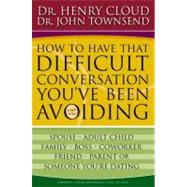
What is included with this book?
| Confident Confrontations | p. 9 |
| Why You Need to Have That Difficult Conversation | |
| The Talk Can Change Your Life | p. 15 |
| The Benefits of a Good Conversation | p. 20 |
| The Essentials of a Good Conversation | |
| Be Emotionally Present | p. 35 |
| Be Clear about "You" and "I" | p. 38 |
| Clarify the Problem | p. 41 |
| Balance Grace and Truth | p. 44 |
| Stay on Task | p. 47 |
| Use the Formula, When You Do "A," I Feel "B" | p. 51 |
| Affirm and Validate | p. 54 |
| Apologize for Your Part in the Problem | p. 59 |
| Avoid "Shoulds" | p. 62 |
| Be an Agent for Change | p. 66 |
| Be Specific | p. 70 |
| Differentiate between Forgiving and Trusting | p. 74 |
| Seeing How It's Done | |
| Telling People What You Want | p. 81 |
| Making Someone Aware of a Problem | p. 103 |
| Stopping a Behavior | p. 126 |
| Dealing with Blame, Counterattack, and Other Problems | p. 157 |
| Getting Yourself Ready to Have the Conversation | |
| Why You Need to Be Ready | p. 183 |
| How to Get Ready | p. 188 |
| Having the Difficult Conversation with People in Your Life | |
| With Your Spouse | p. 207 |
| With Someone You're Dating | p. 219 |
| With Your Child | p. 232 |
| With Your Parent | p. 243 |
| With Adult Children | p. 256 |
| At Work | p. 264 |
| With People in Authority | p. 276 |
| Speaking the Truth in Love | p. 287 |
| Small Group Dicussion Guide | p. 291 |
| Table of Contents provided by Ingram. All Rights Reserved. |
The New copy of this book will include any supplemental materials advertised. Please check the title of the book to determine if it should include any access cards, study guides, lab manuals, CDs, etc.
The Used, Rental and eBook copies of this book are not guaranteed to include any supplemental materials. Typically, only the book itself is included. This is true even if the title states it includes any access cards, study guides, lab manuals, CDs, etc.
Excerpted from How to Have That Difficult Conversation You've Been Avoiding: With Your Spouse, Adult Child, Boss, Coworker, Best Friend, Parent, or Someone You're Dating by Henry Cloud, John Townsend, Cloud
All rights reserved by the original copyright owners. Excerpts are provided for display purposes only and may not be reproduced, reprinted or distributed without the written permission of the publisher.